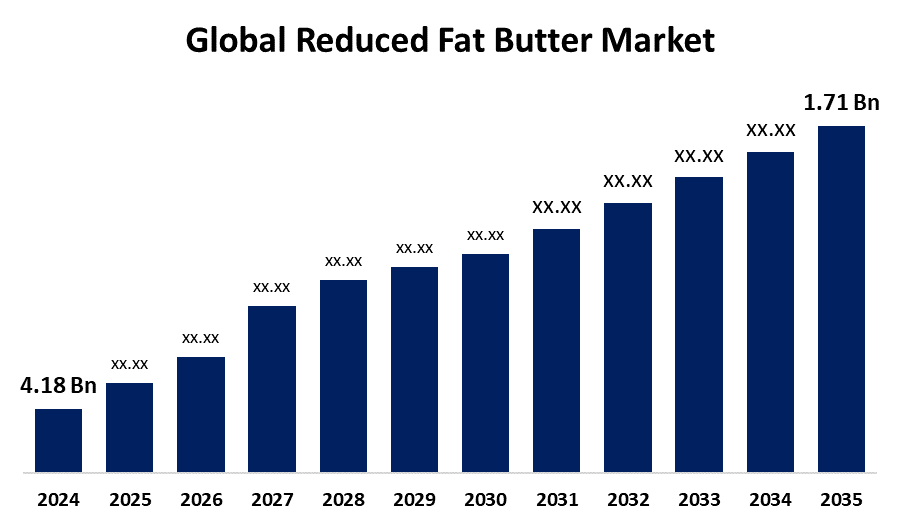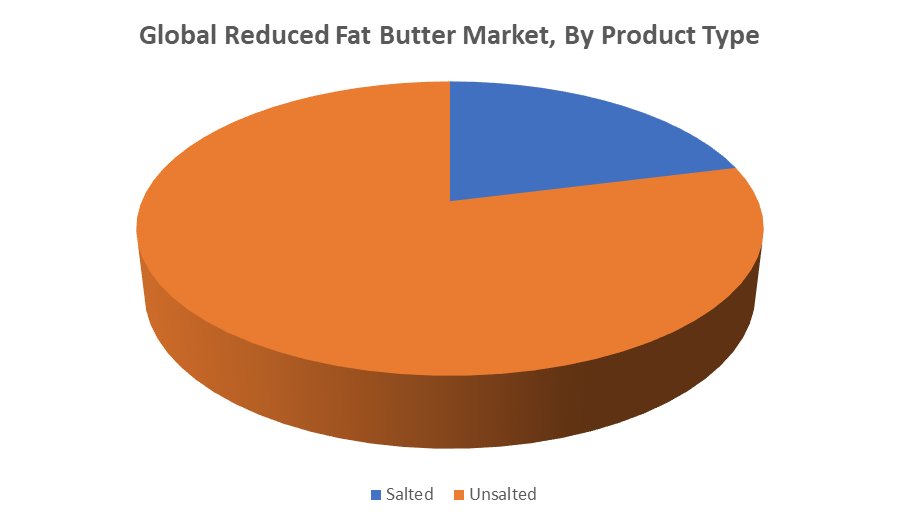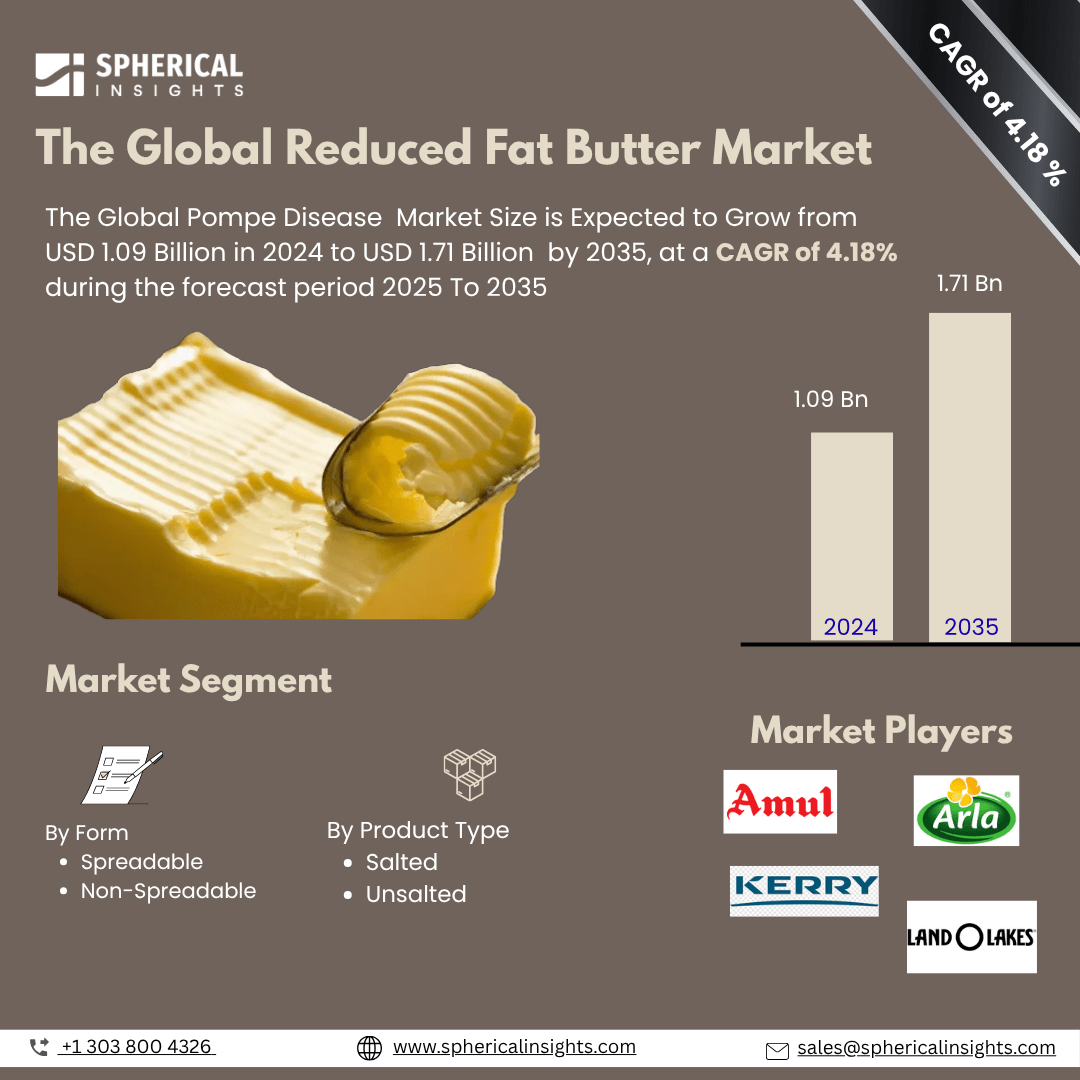Global Reduced Fat Butter Market Insights Forecasts to 2035
- The Global Reduced Fat Butter Market Size Was Estimated at USD 1.09 billion in 2024
- The Market Size is Expected to Grow at a CAGR of around 4.18% from 2025 to 2035
- The Worldwide Reduced Fat Butter Market Size is Expected to Reach USD 1.71 billion by 2035
- North America is expected to grow the fastest during the forecast period.

Reduced Fat Butter Market
The global reduced fat butter market comprises butter products formulated to contain less fat than traditional butter while maintaining a similar taste and texture. These products cater to consumers looking for dairy options with lower saturated fat content. Reduced fat butter is available in various forms, including spreadable and solid blocks, designed to suit different culinary and consumer needs. Manufacturers employ specialized dairy processing techniques to ensure that the reduction in fat does not significantly affect flavor or mouthfeel. The market includes a diverse range of products enriched with nutrients to appeal to healthconscious buyers. Distribution channels span supermarkets, grocery stores, and online platforms, ensuring wide availability and convenience. The market continues to grow steadily as more consumers incorporate healthier alternatives into their diets, making reduced fat butter a significant category within the dairy products sector. Overall, the market reflects an evolving consumer preference toward balanced nutrition and indulgence in dairy based spread
Attractive Opportunities in the Reduced Fat Butter Market
- Developing new flavors and fortified versions of reduced fat butter (e.g., enriched with vitamins, omega 3 fatty acids) can attract health conscious consumers looking for enhanced nutritional benefits.
- Introducing plant-based and lactose free reduced fat butter products can tap into the expanding vegan and lactose-intolerant consumer segments, broadening market reach.
- Collaborating with restaurants, cafes, and bakeries that seek healthier ingredient options offers a significant growth avenue by increasing demand and visibility of reduced fat butter in the foodservice sector.
Global Reduced Fat Butter Market Dynamics
DRIVER: Rising concerns about cardiovascular diseases and obesity
The growth of the global reduced fat butter market is primarily driven by increasing health awareness among consumers who are seeking to reduce their intake of saturated fats and cholesterol. Rising concerns about cardiovascular diseases and obesity have pushed consumers toward healthier dietary choices, making reduced fat butter an attractive alternative to traditional butter. Additionally, the growing demand for functional foods fortified with vitamins and omega 3 fatty acids supports market expansion. Advances in food technology have enabled manufacturers to improve the taste and texture of reduced fat butter, addressing previous concerns about flavor compromises. Furthermore, expanding distribution channels, including supermarkets and e commerce platforms, have made these products more accessible to a wider audience. Marketing campaigns promoting the benefits of reduced fat dairy products also contribute to heightened consumer interest. Overall, the combination of health consciousness, technological innovation, and improved accessibility continues to fuel the adoption and growth of reduced fat butter in the global market.
RESTRAINT: Many consumers associate full fat butter with superior flavor
A primary concern is the perception that reduced fat butter compromises on taste and texture compared to traditional butter. Many consumers associate full fat butter with superior flavor and richness, and the reduced fat content in alternatives may not satisfy these taste preferences, limiting widespread adoption. Additionally, the production of reduced fat butter often involves more sophisticated processing methods, such as the incorporation of emulsifiers or plant-based fats, which can increase manufacturing costs. These higher costs may be passed onto consumers, potentially making reduced fat butter less appealing in price sensitive markets. Fluctuating raw material prices, such as milk and vegetable oils, can impact the profitability of market players. Furthermore, stringent regulations and labeling requirements related to health claims and fat content can pose compliance challenges for manufacturers. These factors collectively contribute to the complexities faced by the reduced fat butter market.
OPPORTUNITY: Growing interest in plant-based and lactose free reduced fat butters
One major opportunity lies in product innovation, such as introducing new flavors or creating fortified versions with added nutrients. There is also growing interest in plant-based and lactose-free reduced fat butters, which can appeal to vegan and lactose intolerant consumers. Partnering with restaurants, cafes, and bakeries can help increase demand, as more foodservice providers look for healthier ingredient options. The trend toward clean label and organic products also opens doors for brands that focus on natural ingredients and simple processing. Additionally, expanding into developing countries, where income levels and awareness of healthy eating are rising, can bring new growth. These opportunities allow companies to stand out in the market and attract a broader range of consumers.
CHALLENGES: Limited consumer awareness in emerging markets
One key issue is limited consumer awareness in emerging markets, where traditional butter is still more familiar and widely accepted. Educating consumers about the benefits and availability of reduced fat butter requires significant marketing efforts. Another challenge is brand loyalty toward established full fat butter products, making it difficult for new or reformulated reduced fat alternatives to gain market share. Moreover, maintaining shelf stability and product consistency without artificial additives can be technically challenging, especially for clean label products. Packaging and storage requirements may also be more demanding, adding to logistical costs. Additionally, intense competition from both traditional dairy and rapidly growing plant based spreads increases pressure on pricing and innovation. These challenges require strategic planning, investment in consumer education, and continuous product development to ensure long term success in the competitive reduced fat butter market.
Global Reduced Fat Butter Market Ecosystem Analysis
The global reduced fat butter market ecosystem includes raw material suppliers (dairy farms), manufacturers, and R D teams focused on developing healthier butter alternatives. Regulatory bodies ensure compliance with food safety and labeling standards. Products are distributed through supermarkets, specialty stores, and online platforms. Consumers, mainly health-conscious individuals, drive demand. Marketing agencies promote nutritional benefits, while competitors such as plant-based spreads and traditional butter influence market dynamics. This interconnected system supports the production, distribution, and innovation of reduced fat butter, responding to evolving dietary preferences and health trends worldwide.
Based on the form, the spreadable segment dominated the global reduced fat butter market, with the highest share over the forecast period

The spreadable segment dominated the global reduced fat butter market and is expected to maintain the highest share over the forecast period. This is largely due to its convenience, ease of use, and widespread application in daily meals such as toast, sandwiches, and baking. Spreadable reduced fat butter offers a balance between health benefits and functionality, making it especially popular among health conscious consumers seeking lower-fat alternatives without compromising on texture and taste. Its popularity in both household and foodservice sectors further supports its leading market position.
Based on the product type, the unsalted segment held a dominant market share over the forecast period

The unsalted segment dominance is attributed to its versatility in cooking and baking, where precise control over salt content is important. Unsalted reduced fat butter is preferred by healthconscious consumers aiming to manage sodium intake while still enjoying the taste and texture of butter. Its neutral flavor also makes it suitable for a wide range of recipes, contributing to its strong demand across both household and commercial food preparation settings.
Europe is anticipated to hold the largest market share of the reduced fat butter market during the forecast period
Europe is anticipated to hold the largest market share of the reduced fat butter market during the forecast period. This dominance is driven by strong consumer awareness regarding health and nutrition, well established dairy industries, and stringent food regulations that promote healthier alternatives. European consumers increasingly prefer low fat dairy products as part of balanced diets, boosting demand for reduced fat butter. Additionally, high purchasing power, widespread availability of premium dairy brands, and innovation in product offerings contribute to the region’s leading position in the global market.
North America is expected to grow at the fastest CAGR in the reduced fat butter market during the forecast period
North America is expected to grow at the fastest rate in the reduced fat butter market during the forecast period. This growth is mainly due to increasing health awareness among consumers who are looking for lower fat dairy options to support better nutrition and weight management. Major food brands in the region are expanding their reduced fat butter offerings, and new product innovations are helping meet changing consumer preferences. The strong presence of retail chains, the rise of online grocery shopping, and supportive health regulations are also contributing to this rapid market growth across the U.S. and Canada.
Recent Development
- In July 2024, Kerry Group announced a 35 million investment in a new production facility in Ireland, aimed at manufacturing reduced-fat butter and other health oriented dairy products. This expansion is expected to increase production capacity by 20% and generate approximately 60 million in additional revenue by the end of 2025.
- In March 2024, Arla Foods introduced a new range of reduced fat butter across Europe, containing 40% less fat than traditional butter. This launch is expected to generate an additional revenue of EUR 50 million for Arla Foods in the next two years.
Key Market Players
KEY PLAYERS IN THE REDUCED FAT BUTTER MARKET INCLUDE
- Amul (GCMMF)
- Arla Foods
- Kerry Group
- Land O'Lakes
- Unilever (Upfield)
- Fonterra Co operative Group
- Lactalis Group
- Danone
- Müller Group
- Dairy Farmers of America
- Others
Market Segment
This study forecasts revenue at global, regional, and country levels from 2020 to 2035. Spherical Insights has segmented the reduced fat butter market based on the below-mentioned segments:
Global Reduced Fat Butter Market, By Form
- Spreadable
- Non Spreadable
Global Reduced Fat Butter Market, By Product Type
Global Reduced Fat Butter Market, By Regional Analysis
- North America
- Europe
- Germany
- UK
- France
- Italy
- Spain
- Russia
- Rest of Europe
- Asia Pacific
- China
- Japan
- India
- South Korea
- Australia
- Rest of Asia Pacific
- South America
- Brazil
- Argentina
- Rest of South America
- Middle East & Africa
- UAE
- Saudi Arabia
- Qatar
- South Africa
- Rest of the Middle East & Africa






